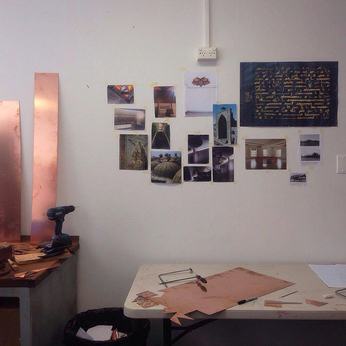
R
E
V N
E
X
T
At the “When South is North” conference organized by Sydney’s 4A Centre for Contemporary Asian Art and the Institute for Culture and Society at Western Sydney University, Karachi-based artist ADEELA SULEMAN discussed her practice in relation to the political tensions and everyday realities in Pakistan. Photo by Kai Wasikowski. Courtesy 4A Centre for Contemporary Asian Art.
Fusing Identities: When South is North
The City of Parramatta, a quick express train ride away from Sydney’s central business district, is regarded as a culturally, ethnically and religiously diverse hub within Western Sydney. Many local council initiatives and businesses reflect this sense of multiculturalism, with growing interests in culturally specific tourism, festivals and business ventures. On the flip side, in recent years, some residents in the city have witnessed discrimination in response to encroaching Islamophobia, the growth of anti-intellectual discourse and anti-refugee rhetoric. Therefore, Parramatta was the ideal location for an urgent discussion about the complexities and multifaceted nature of the South-Asian-Australian identity, titled “When South is North.”
The symposium was organized by Sydney’s 4A Centre for Contemporary Asian Art and the Institute for Culture and Society at Western Sydney University (WSU), and hosted at the latter institution. The day began with a welcome by Paul James, director of the university’s Institute of Society and Culture, who was then joined by 4A director Mikala Tai, setting the scene for “When South is North.” Tai remarked that the urgency for the symposium was in the context of 4A’s new scope and outlook toward South Asia. She admitted that the gallery had not yet spent enough time with voices from the region, and the conference was the first step to fill in the blind spot.
Associate professor Devleena Ghosh of University of Technology, Sydney, took the stage for the first presentation, and discussed her research into culture and commerce in countries that have a connection to the Indian Ocean. The next speaker was artist Reena Kallat, visiting from Mumbai, who discussed her culturally specific practice that draws from the forgotten histories of India, and encapsulates themes of memory and loss. The first half of the symposium rounded off with a panel discussion titled “Art in, of, from, South Asia? Artists Working Across Cultures and Geographies,” moderated by 4A program manager Pedro de Almeida, with a roster of speakers who are all artists—Reena Kallat, Ramesh Mario Nithiyendran, Nusra Latif Qureshi, Adeela Suleman and Abdullah MI Syed.
After lunch, guests were guided a block away to Parramatta Artist Studios (PAS), where visitors squeezed into the residency program building to hear and see the creations of artists in residence—Khadim Ali, Salote Tawale, Kalanjay Dhir, Marikit Santiago and many more. A favorite Instagram shot for visitors was a site-specific work in the elevator that is part of “You Are One of the Reasons I Make Art” (2015–16), a collaborative project by Hayley Megan French & Carla Liesch, past artists in residence at PAS.
In the afternoon, Vidya Shivadas, director of New Delhi’s Foundation for Indian Contemporary Art (FICA), contexualized the contemporary art ecology in India by looking at case studies from a range of institutions in the country, including FICA’s work with the Kochi-Muziris Biennale in producing a student biennial in South India. Following this was a tight panel titled “Situating South Asian Arts and Culture in Australia” moderated by Pakistani-born New South Wales Greens MP Mehreen Faruqi—the first Muslim MP in Australia—with speakers Sunil Badami, Melanie Eastburn, Amrit Gill, Gary Paramanathan and S. Shakthidharan. This panel was a core component of the event, and explored the many, varied perspectives on how to ethically engage with South-Asian-Australian creative practices without disregarding one identity to highlight the other. The speakers urged audience members to resist the tendency to sensationalize, tokenize or homogenize specific cultures. To drive home the point, Indian-Australian writer Sunil Badami shared a memorable encounter: “A colleague once asked me if I speak ‘Indian,’ and I don’t because I was raised in Australia. She was projecting stereotypical attitudes. Why is there this expectation for culturally diverse Australians to perform their heritage?”
The first panels, “Art in, of, from, South Asia? Artists Working Across Cultures and Geographies” was moderated by Pedro de Almeida, with speakers REENA KALLAT, RAMESH MARIO NITHIYENDRAN, NUSRA LATIF QURESHI, ADEELA SULEMAN and ABDULLAH MI SYED. Photo by Kai Wasikowski. Courtesy 4A Centre for Contemporary Asian Art, Sydney.
Rounding off the day, powerhouse Karachi-based artist Adeela Suleman offered a sobering discussion about her practice in relation to the political tensions and everyday realities in Pakistan, demonstrating her supreme dedication to art and activism that has allowed her to persevere in times of crisis, tying up “When South is North” with a motivational end.
Mikala Tai’s remarks reflect that South Asian art practitioners—whether defined by their nationality or heritage—certainly should hold a more visible position in the Australian art scene. To make that happen, we must first consider the ethics, protocols and channels of collaboration, and even engage in conversations that examine the matter of diversity in Australian society. With that in mind as we move forward, “When South is North” will serve as a touchstone not only for my own curatorial practice, but many others as well.
“When South is North” took place at Western Sydney University on August 16, 2017.
To read more of ArtAsiaPacific’s articles, visit our Digital Library.







